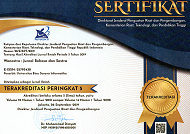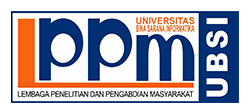Defamiliarization Through Myth: A Pastiche Reading of The Sword of Summer
Abstract
Full Text:
PDFReferences
Abrams, M. H., & Harpham, G. G. (2012). A glossary of literary terms (10th ed.). Boston: Wadsworth Cengage Learning.
Carter, D. (2012). Literary theory. Oldcastle Books
Creswell, J. W. (2014). Research Design: Qualitative, Quantitative and Mixed Methods Approaches (4th ed.). London: Sage Publications Ltd.
Eco, Umberto. (19941990). The limits of interpretation. Indiana University Press.
Erliani, H., Daru Kuncara, S., & Sari Lubis, I. (2019). THE JOURNEY OF MAGNUS CHASE’S CHARACTER AS MYTHICAL HERO IN THE SWORD OF SUMMER NOVEL BY RICK RIORDAN. In Jurnal Ilmu Budaya (Vol. 3, Issue 2).
Hutcheon, L. (1989). Historiographic Metafiction Parody and the Intertextuality of History.
Jadeeda Saleem. (2023). Tishani Doshi’s “Listening to Abida Parveen on Loop I Understand Why I Miss Home and Why It Must Be So”: A Pastiche and Epitome of Hypernationalism. Shanlax International Journal of English, 12(S1-Dec), 43–45. https://doi.org/10.34293/rtdh.v12is1-dec.88
Jameson 1992_Postmodernism, or The Cultural Logic of Late Capitalism. Duke University Press.
Jameson (2016) Postmodernism and consumer society. In Postmodernism (pp. 62–92). Routledge.
Jweid, A. N. A. A. (2023). Narcissistic Pastiche: Towards Exploring the Concept of “Cras es noster” Through Nostalgic Postmodernism in John Green’s The Fault in Our Stars. English Language and Literature Studies, 13(1), 21. https://doi.org/10.5539/ells.v13n1p21
Khabibullaeva, R. M., & Riordan, R. (2020). ANALYSIS OF PASTICHE IN THE NOVEL “THE LIGHTNING THIEF.” https://doi.org/10.15863/TAS
Ryan, M. L. (2001). Beyond Myth and Metaphor. consultant, 1983, 91.
Shklovsky, V., & Berlina, A. (2015). Art, as device. Poetics Today, 36(3), 151–174. https://doi.org/10.1215/03335372-3160709
Wulandari, L. D. (2017). Pastiche of Cinderalla in Kiera Cass The Selection. A postmodern study.
Zhu, Y. (2023). Analysis of the Death in Ariel from the Perspective of Pastiche. Communications in Humanities Research.
DOI: https://doi.org/10.31294/wanastra.v17i2.26079
Copyright (c) 2025 Linul Qalbi Ashlihatul Mukarramah, Agung Wiranata Kusuma

This work is licensed under a Creative Commons Attribution-ShareAlike 4.0 International License.
Index by:
| | | |
Published by Department of Research and Public Service (LPPM) Universitas Bina Sarana Informatika with supported Relawan Jurnal Indonesia
Kramat Raya Street No.98, Kwitang, Kec. Senen, Central Jakarta, DKI Jakarta 10450

This work is licensed under a Creative Commons Attribution-ShareAlike 4.0 International License






